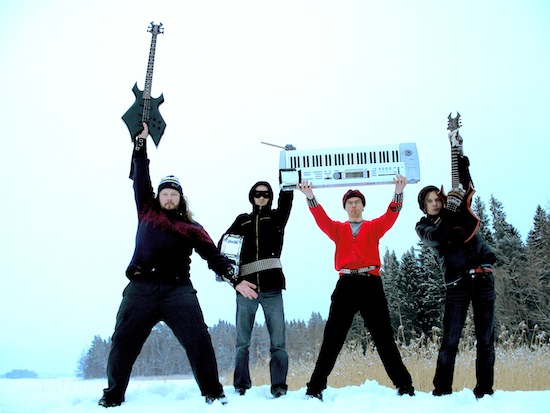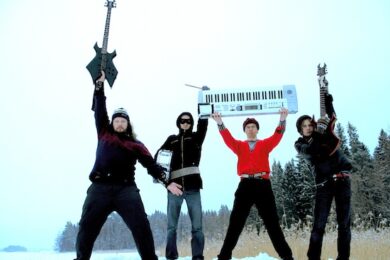Jussi Lehtisalo, the driving force behind Finnish legends Circle, has seen and done more with his band than most – it’s less a case of ‘what do they sound like’ as it is ‘what do they sound like at this particular moment.’ The easy answer is always ‘awesome’, such is the case for their latest release Six Day Run, soundtracking Mika Taanila’s documentary film of the same name focussing on an endurance race lasting said length of time (and which inspired Quietus writer JR Moores to set out to find the best music to run to in a http://thequietus.com/articles/12437-music-for-running jogging-based experiment). Reached via e-mail, Lehtisalo also demonstrates he has more intelligent – and absolutely stone-faced blackly humorous – things to say in his second language than nearly all English-speaking groups do in their first:
The theme of Six Day Run as a film, at least from what I can sense in the description, lies in both the possibilities of repetition and extremity and how they intertwine, something which, in turn, calls to mind Circle’s work. Do you find that where Circle goes each time they record and perform is something that surprises you, or does it follow a certain path in your collective creative consciousness to start with?
Jussi Lehtisalo: The aim of repetition in Circle’s music is to tune our group of rationally thinking scientists into a transcendental state, where sense and experience have meanings that are different from our usual way of comprehension. We use the ritual – that is music – for creating a connection, so that our collective consciousness would start to perceive much vaster entities than it is possible to perceive with just one individual. Looking at the highly individualistic extreme sport, it seems to me that they have a somewhat narcissistic and holistic approach. The vibes are acquired by the cost of worried fellow men.
Adding improvisation to live performance refreshes the whole situation, it always brings some surprises. It is not so bad to make a fool of yourself in the art reality, which is, though, more real to me than everyday life. With Circle we are often striving after a magnificent spectacle that would strengthen our identity as an over-powerful, marvellous group but we usually end up with embarrassment and a shared sense of shame with the audience. That is exactly the moment when art wakes up from its sleep and we slip out from the pretentious, never-ending job interview reality.
Had you worked with Mika Taanila or any other filmmaker on a soundtrack before this? Did you find this potentially limiting or did working within a structure provide a chance to explore in different directions? Did you receive a final cut of the movie first before moving forward?
JL: I met Mika Taanila for the first time at the beginning of the 1990s. He shot 8mm footage of Circle’s first gig in Helsinki and he already seemed very enthusiastic then. We were from a small west coast town, and we came to the capital city to rule the roost.
Personally I am not the biggest fan of film music. For me, music is a more developed form of photography or cinematography. Often in films, music becomes subordinated to what we see, and it seems that its only purpose is to elevate the picture. I’m not that keen in combining these elements; I would rather keep art forms separate from each other. Bela Tarr’s Sátántangó is a great example of a film without music – the picture is strong enough to live without support from the king of the art forms, music. Of course, I say this with a little wink.
We started making the score for Six Day Run after some conversations with Taanila, and he showed us some early stage edits, in which he used 1990s Circle tracks as a reference. Inspired by that, and keeping Taanila’s wishes in mind, I started composing. I forced myself back into the mood of the early times of Circle. From that outdated standpoint I noticed that I had lost something especially fascinating during these years. By going back 20 years in time I reached freshness and minimalism that was forgotten at this time, which is more active and more entertainment-driven.
The theme of the film, a run spread out over days, allows a steady progression of different musical states in the album. Beyond its requirement to function as a soundtrack, how do you regard the album as a stand-alone piece of music? The sense of each day as a self-contained moment is strong; I’m especially taken by the drumming on ‘Day Three’ as a standout element.
JL: The music is made to stand on its own stiff feet from the beginning. The ‘reality’ in the film is the picture to which the music gives a broader perspective. The ‘reality’ on the album is the music, and labelling it as soundtrack reduces its responsibility to be self-supporting.
Personally I think that all music should be half-done, it should include the sense of something missing. Finalising a piece of art is the receiver’s job, which makes the role of him or her essential. I am tired of being charmed by the overpower of artists and the passive way experiencing music. All that seems to be worshipped in the present time that seeks the perfectness of art.
Do you find each album you create a final finished product or more a snapshot of a moment in creative time? Do you think there is ever a final form for any of the music you create?
JL: All the entertainment and all the shit has succeeded in making itself relevant at the time of its birth. That is the meaning of the hype, advertising and social media. What is watered-down in the process is the original sincere and disinterested inspiration. The marketing personnel, the producers and all kinds of two-bit hustlers keep pushing forward loathsome and sickening products. I believe that really interesting art is always asleep when it is born. It is like a time bomb, waiting for the moment to explode. Here’s a brilliant quote from [Finnish band] Keuhkot: "I’m sitting and waiting for the world to catch up with me, but I realize that I have moved a hundred years further!". When art springs up from independent sources and sincere sunshine, there is only one possible form for each piece of art – there is nothing to add to or nothing to cut off from it by any third party gatekeeper.
Does each piece come together in general performance and playing, or does it begin with a key instrument or composition each time that is then added to? Or does this vary depending on circumstance and mood?
JL: Mainly we just start doing something. Making noises, bringing out ideas, giving ourselves deadlines short enough and dragging our bones to the same town to do all this. We don’t put too much pressure on ourselves, no special goals for the content or quality. We enjoy each other’s company, try to be creative and try to give up our overspecialised tastes and sense of aesthetics. It is the art that suffers if the artist starts to be selective on the basis of his own ego-boosting opinions or gets overambitious by the cost of the other members of the group.
What are other upcoming plans for Circle, if anything specific is being done at present?
JL: We are going to rent the Circle brand name to a death metal band and start making adult oriented rock under the name Falcon (ex-Circle). As you see, we will still try to get the benefit of our old reputation. The band with the rented Circle name will make death metal, like before. At some point the contract will expire and we will get the burden of the Circle brand back. Then we will go on making music as Circle (ex-Falcon) as if nothing happened.



